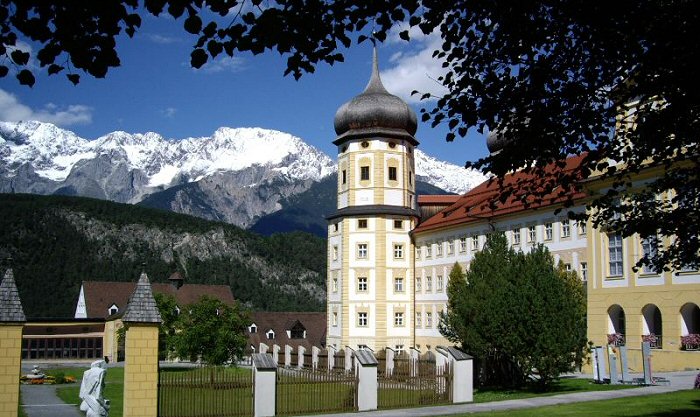The Cistercian monastery of Stams is located in the Austrian Upper Inn Valley about 35 km west of Innsbruck and can be seen from far away.

The monastery was founded by Elisabeth of Bavaria in 1272. It became an important economic centre of the region, privileges were extended, fiefs existed as far as the Swabian area and Bavaria. In the 14th century, the Stamser Fathers were even entrusted with the preservation of the imperial regalia for several decades.
In the 16th century the monastery was plundered in the course of the peasant uprisings and in 1152 Elector Moritz of Saxony devastated the monastery again in the turmoil of the Schmalkaldic Wars. Finally, in 1593 a large fire destroyed large parts of the monastery complex.
The Baroque reconstruction took place between 1650 and 1750, during which, among other things, the two striking "onion towers" were built. The baroque and rococo interior of the church also dates from this period.
After the turmoil of the Second World War, the collegiate church was thoroughly renovated under Abbot Bernhard (1973-1985).
The Cistercians in the Middle Ages
Die Staufer
Friedrich v. Büren †1094
Friedrich I, Hg. v. Schwaben †1105
Friedrich II Kg. Konrad III.
Hg. v. Schwaben 1138-1152
†1147
Ks. Friedrich I. Barbarossa 1152-1190
Ks. Heinrich VI. 1190-1197
Ks. Friedrich II. 1212/15-1250
Kg. Konrad IV. 1237-1257
Konradin †1268
The story of Elisabeth of Bavaria and how the Stams monastery was founded.
Bei During a stay of Emperor Friedrich II in Bavaria in 1235, he engaged his seven-year-old son Konrad to Elisabeth (born around 1227), the daughter of Duke Otto II the Illustrious of Bavaria, and Agnes, daughter of Heinrich, Count Palatine near Rhine. The marriage took place in 1246. Konradin became the only child from this marriage. King Konrad IV, who never saw his son, died only two years after his birth. After Konrad's death, the concern was for her son Konradin and the task of preserving his paternal inheritance. Before leaving for Wasserburg am Inn, Elisabeth stayed with little Konradin, initially with her brother, Duke Ludwig II, the Strict of Bavaria, who was Konrad's guardian. Queen Elisabeth was present when he had his wife Maria of Brabant executed on 18 January 1256, probably without reason.
It is understandable that the mother withdrew her son from this guardian. He came into the care of Bishop Eberhard of Constance, where he spent a happy childhood, enjoyed an excellent upbringing and was instructed in chivalric exercises such as minnesong.
Five years after the death of her first husband, Elizabeth entered into a second marriage with Meinhard II in 1259. Counts of Gorizia and Tyrol. Konradin seems to have remained in Constance during this time - he is said to have later disapproved of his mother's marriage, which was not in keeping with his social status.
She stubbornly defended her son's right as successor to Conrad IV against Manfred, who wanted to assert the Sicilian heritage of the Staufers.
After Manfred's death in the Battle of Benevento in 1266, Konradin decided, after a busy life in Germany, to move to Italy himself and fight for the Staufer southern empire. After a brilliant court day in Augsburg in 1266, Konradin fixed his move to Italy for the late summer of 1267. His mother strongly advised that he should be content with a peaceful and quiet life in his duchy, his guardian and uncle advised him to take the train to Italy.
On August 22, 1267 Conradin said goodbye to his mother in Hohenschwangau. In Castle Tyrol, where Elisabeth now lived, she received the news of her defeat at Tagliacozzo and the execution of her son.
The reports about where the dead Konradin was taken to contradict each other. One of them says, "that Elizabeth hurried to Naples, but came too late and was only given permission to build a chapel over his grave. This report does not seem very credible. Conrad's tomb is today in the church of S. Maria del Carmine in Naples.
In 1272, Elisabeth had a monastery built in Stams by her second husband Count Meinhard II of Gorizia-Tyrol in memory of Conradin, in place of a wooden pilgrimage chapel in the middle of old oak woods, dedicated to John the Baptist and looked after by twelve monks.
The second marriage of Elizabeth produced four sons and two daughters. Their daughter Elizabeth married Albrecht I of Habsburg. When her husband was murdered in Windisch (Switzerland, Aargau), she founded the monastery there.
Elisabeth of Bavaria died in 1273 at Gojen Castle above Meran before the Stams Monastery was completed. She was first buried at Castle Tyrol, and then ceremonially buried in Stams in 1284. Her husband was buried at her side in 1298. Four children of Meinhard and Elisabeth also rest there.
For the next 35 km to Innsbruck, the Inn Valley Cycle Path runs a little off the motorway. Only at Zirl it gets uncomfortable again, so close to the highway. Finally I was in Innsbruck, which was full of tourists as usual and it was hard to find a place to stay overnight.


Inn Valley Cycle Path

